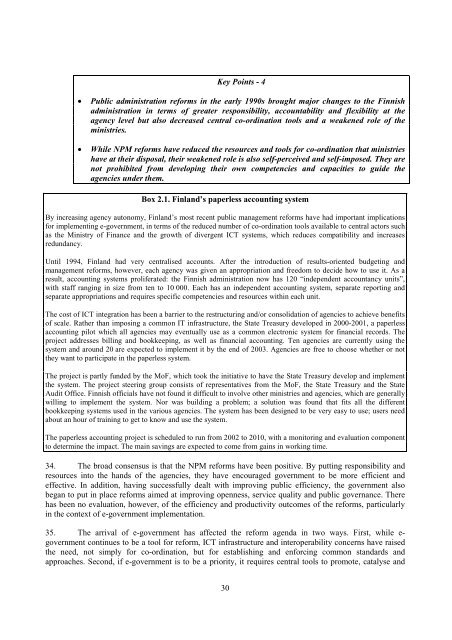e-GOVERNMENT IN FINLAND - ePractice.eu
e-GOVERNMENT IN FINLAND - ePractice.eu
e-GOVERNMENT IN FINLAND - ePractice.eu
You also want an ePaper? Increase the reach of your titles
YUMPU automatically turns print PDFs into web optimized ePapers that Google loves.
Key Points - 4<br />
x Public administration reforms in the early 1990s brought major changes to the Finnish<br />
administration in terms of greater responsibility, accountability and flexibility at the<br />
agency level but also decreased central co-ordination tools and a weakened role of the<br />
ministries.<br />
x While NPM reforms have reduced the resources and tools for co-ordination that ministries<br />
have at their disposal, their weakened role is also self-perceived and self-imposed. They are<br />
not prohibited from developing their own competencies and capacities to guide the<br />
agencies under them.<br />
Box 2.1. Finland’s paperless accounting system<br />
By increasing agency autonomy, Finland’s most recent public management reforms have had important implications<br />
for implementing e-government, in terms of the reduced number of co-ordination tools available to central actors such<br />
as the Ministry of Finance and the growth of divergent ICT systems, which reduces compatibility and increases<br />
redundancy.<br />
Until 1994, Finland had very centralised accounts. After the introduction of results-oriented budgeting and<br />
management reforms, however, each agency was given an appropriation and freedom to decide how to use it. As a<br />
result, accounting systems proliferated: the Finnish administration now has 120 “independent accountancy units”,<br />
with staff ranging in size from ten to 10 000. Each has an independent accounting system, separate reporting and<br />
separate appropriations and requires specific competencies and resources within each unit.<br />
The cost of ICT integration has been a barrier to the restructuring and/or consolidation of agencies to achieve benefits<br />
of scale. Rather than imposing a common IT infrastructure, the State Treasury developed in 2000-2001, a paperless<br />
accounting pilot which all agencies may eventually use as a common electronic system for financial records. The<br />
project addresses billing and bookkeeping, as well as financial accounting. Ten agencies are currently using the<br />
system and around 20 are expected to implement it by the end of 2003. Agencies are free to choose whether or not<br />
they want to participate in the paperless system.<br />
The project is partly funded by the MoF, which took the initiative to have the State Treasury develop and implement<br />
the system. The project steering group consists of representatives from the MoF, the State Treasury and the State<br />
Audit Office. Finnish officials have not found it difficult to involve other ministries and agencies, which are generally<br />
willing to implement the system. Nor was building a problem; a solution was found that fits all the different<br />
bookkeeping systems used in the various agencies. The system has been designed to be very easy to use; users need<br />
about an hour of training to get to know and use the system.<br />
The paperless accounting project is scheduled to run from 2002 to 2010, with a monitoring and evaluation component<br />
to determine the impact. The main savings are expected to come from gains in working time.<br />
34. The broad consensus is that the NPM reforms have been positive. By putting responsibility and<br />
resources into the hands of the agencies, they have encouraged government to be more efficient and<br />
effective. In addition, having successfully dealt with improving public efficiency, the government also<br />
began to put in place reforms aimed at improving openness, service quality and public governance. There<br />
has been no evaluation, however, of the efficiency and productivity outcomes of the reforms, particularly<br />
in the context of e-government implementation.<br />
35. The arrival of e-government has affected the reform agenda in two ways. First, while egovernment<br />
continues to be a tool for reform, ICT infrastructure and interoperability concerns have raised<br />
the need, not simply for co-ordination, but for establishing and enforcing common standards and<br />
approaches. Second, if e-government is to be a priority, it requires central tools to promote, catalyse and<br />
30
















